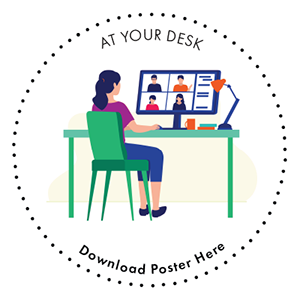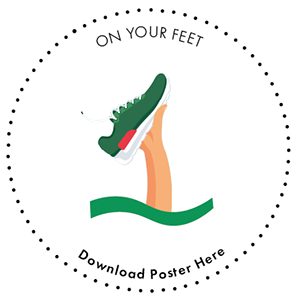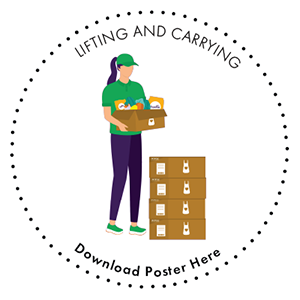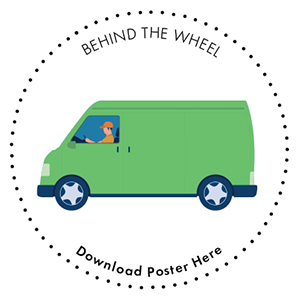Adapt Your Workplace for Arthritis
Small adjustments to your workspace can provide big payoffs in improved comfort, job satisfaction, productivity and performance.
By Mary Anne Dunkin
For most of us, a job means more than a paycheck — it’s also how we use or skills and talents, interact with others and contribute to society. But when arthritis flares or 5 o'clock consistently finds you aching and exhausted, you may find yourself wondering how you can continue working.
Fortunately, there are ways. Whether your workplace is an office, warehouse, delivery truck, sales floor or a desk in the corner of your living room post-COVID, modifications in your work setting and the way you work can help you get through the workday with more energy and less pain.
Here’s how:
If hours of sitting, filing, answering phones or using a keyboard are taking a toll on your hips, spine, shoulders and hands, consider the following tips and tools.
The proper chair. Use an adjustable chair that allows you to sit comfortably with your feet on the floor and your hands at your keyboard when your arms are bent at a 90- to 120-degree angle. Use a chair with good lumbar support to maintain the natural curve of your lower back.
Footrest. When sitting at your desk, your feet should be flat on the floor and your thighs should be parallel to the floor. If your feet don’t sit flat when your chair is at a comfortable height for your desk, try a footrest to maintain proper posture.
Computer monitor platform. Your computer monitor should be at or slightly above eye level. Placing a platform under your computer monitor can raise it to the appropriate eye level, preventing the need to look up, down or to the side for extended periods.
A sit-to-stand desk. Consider an adjustable desk that enables you to change positions — from a seated to standing position — throughout the day to prevent stiffness or too much stress on any particular joints.
Voice recognition software. If arthritis in your hands makes it difficult to use a mouse and keyboard, voice recognition software can allow you to perform tasks like writing emails, creating documents and conducting online searches with less stress on your fingers, hands and wrists.
Frequent breaks. Take breaks throughout the day to stand up, walk around and do gentle stretching exercises. Some exercises can be done while sitting at your desk.
Perfect posture. Poor posture can lead to pain or exacerbate arthritis symptoms. Improving your posture can help prevent pain and stiffness from sitting. How do you know if your posture is not perfect? Have a coworker use your smart phone to take a video of you working at your desk. Then share the video with an occupational therapist, who can recommend postural changes or, if necessary, changes to the work station.
Whether you’re working in a warehouse, a health care setting or behind a cash register, constant standing can stress the joints of your feet, ankles, knees hips and spine. Try the following to reduce the stress.
Supportive shoes. Choose shoes with good arch support to distribute weight evenly and reduce strain on the joints, ample cushioning to absorb shock and reduce impact on the feet and joints, a wide toe box to avoid cramping painful toes, and low or no heels to maintain natural foot positioning and balance. Also consider getting custom orthotic insoles made by a podiatrist or physical therapist to provide additional support tailored to your specific needs.
Anti-stress/fatigue mats. If you stand in one place much of the day, consider using a mat designed to reduce discomfort and fatigue. Made from materials like foam, gel, or rubber, anti-stress mats provide a cushioned surface that absorbs the shock of standing and reduces pressure on the feet, legs and back.
Ramps and elevators. When possible, choose ramps and elevators over stairs. If you must use stairs, always use the handrail for support. If one leg is more severely affected, step up with the stronger leg first when climbing stairs, then follow with the weaker or more painful leg. When going down steps, step down with your weaker, more painful leg, then follow with the stronger one.
Compression hose. Compression hose help improve blood flow in the legs by applying graduated pressure, which can reduce swelling and prevent blood pooling and swelling in feet and ankles. Improved circulation and reduced swelling can help alleviate pain and discomfort. Speak with your doctor or occupational therapist or physical therapist about the best hose for you.
Frequent breaks. Take breaks to sit and elevate your feet. Also do gentle exercises, such as ankle circles to improve circulation and reduce pain and stiffness. While seated comfortably with your feet flat on the floor, lift one foot off the ground slightly and slowly rotate your ankle in a circular motion, first clockwise and then counterclockwise. Perform 10 to 15 circles in each direction, then switch feet and repeat the exercises.
If your job involves lifting or carrying, these modifications and tips can help spare the joints of your shoulders, arms, hands and spine.
Wheeled carts. Instead of carrying packages, supplies or files between offices or different areas of your workplace, transport them on a wheeled cart. Doing so will not only spare your hands and shoulders but will also provide some support while walking.
Braces. Consider a back brace to help provide support and stability, reduce back strain, limit excessive movement, and maintain proper posture when lifting. Speak with your doctor or occupational therapist about the appropriate brace for you. Some employers may require a back brace for heavy lifting.
Hand protection. Try devices, such as a wrist brace, to support your hands and reduce pain when lifting. Arthritis gloves can provide compression and warmth, helping to reduce pain and improve grip strength.
Grabbers/reachers. To reduce bending and stretching, use grabbers or reachers to retrieve small, lightweight items from the floor or high shelves.
Strengthening exercises. Work with a physical therapist on a plan of exercises to strengthen the shoulder, arm, core and back muscles. Doing so can help support your spine to reduce the risk of injury when lifting heavy objects. You can do the same with an occupational therapist or hand therapist to help increase hand strength and dexterity for grasping items to lift or for performing other work-specific tasks.
If your job involves driving clients, making deliveries or just commuting to and from work in your personal vehicle, sitting can lead to back and hip pain, and gripping the wheel can be difficult for painful hands. Try these tips and devices to make your drive easier.
A seat that fits. Adjust the seat height and position to ensure proper posture, allowing your feet to reach the pedals without stretching. Use a supportive seat cushion or ergonomic seat cover to reduce pressure on your back and hip and/or consider a lumbar support cushion to maintain the natural curve or your spine.
Simple steering. Adjust the steering wheel to best suit you and use a steering wheel cover with extra grip to make turning the wheel easier. Or consider installing a steering wheel knob, aka a brody knob — a small, round knob that is mounted to the outer rim of the steering wheel — which enables you to grip and steer the wheel with one hand.
Reachable pedals. Make sure the accelerator and brake pedals are within easy reach and do not require excessive force to operate. If reaching the pedals is difficult, pedal extenders may be an option.
Easy access. Try using a beaded seat cover that makes it easier to slide over the seat to enter and exit the car or a swivel seat cushion that makes it easier to turn in your seat.
A safe pace. If possible, plan your route to minimize time in the vehicle. For longer trips, try to take brief breaks to stretch and move around. Do gentle stretching exercises focusing on your hands, wrists, back and legs.
The right car. When looking for a new car — or putting in requests for a vehicle you will be driving for work — here are some important features to consider: automatic transmission, power steering, heated seats and steering wheel and keyless entry and ignition.
If you continue to have issues with pain and/or fatigue or if a painful task comprises a large part of your job, consult an occupational therapist, who can prescribe orthotic devices or offer advice for more specific modifications. Some will even come to your workplace to observe you while you work and make recommendations. You can also seek the assistance of a driver rehabilitation specialist, an occupational therapist who has special training to assist with your driving challenges and modify your driving and your vehicle to meet your needs behind the wheel.
For most of us, a job means more than a paycheck — it’s also how we use or skills and talents, interact with others and contribute to society. But when arthritis flares or 5 o'clock consistently finds you aching and exhausted, you may find yourself wondering how you can continue working.
Fortunately, there are ways. Whether your workplace is an office, warehouse, delivery truck, sales floor or a desk in the corner of your living room post-COVID, modifications in your work setting and the way you work can help you get through the workday with more energy and less pain.
Here’s how:
 At Your Desk
At Your Desk
If hours of sitting, filing, answering phones or using a keyboard are taking a toll on your hips, spine, shoulders and hands, consider the following tips and tools. The proper chair. Use an adjustable chair that allows you to sit comfortably with your feet on the floor and your hands at your keyboard when your arms are bent at a 90- to 120-degree angle. Use a chair with good lumbar support to maintain the natural curve of your lower back.
Footrest. When sitting at your desk, your feet should be flat on the floor and your thighs should be parallel to the floor. If your feet don’t sit flat when your chair is at a comfortable height for your desk, try a footrest to maintain proper posture.
Computer monitor platform. Your computer monitor should be at or slightly above eye level. Placing a platform under your computer monitor can raise it to the appropriate eye level, preventing the need to look up, down or to the side for extended periods.
A sit-to-stand desk. Consider an adjustable desk that enables you to change positions — from a seated to standing position — throughout the day to prevent stiffness or too much stress on any particular joints.
Voice recognition software. If arthritis in your hands makes it difficult to use a mouse and keyboard, voice recognition software can allow you to perform tasks like writing emails, creating documents and conducting online searches with less stress on your fingers, hands and wrists.
Frequent breaks. Take breaks throughout the day to stand up, walk around and do gentle stretching exercises. Some exercises can be done while sitting at your desk.
Perfect posture. Poor posture can lead to pain or exacerbate arthritis symptoms. Improving your posture can help prevent pain and stiffness from sitting. How do you know if your posture is not perfect? Have a coworker use your smart phone to take a video of you working at your desk. Then share the video with an occupational therapist, who can recommend postural changes or, if necessary, changes to the work station.
 On Your Feet
On Your Feet
Whether you’re working in a warehouse, a health care setting or behind a cash register, constant standing can stress the joints of your feet, ankles, knees hips and spine. Try the following to reduce the stress.Supportive shoes. Choose shoes with good arch support to distribute weight evenly and reduce strain on the joints, ample cushioning to absorb shock and reduce impact on the feet and joints, a wide toe box to avoid cramping painful toes, and low or no heels to maintain natural foot positioning and balance. Also consider getting custom orthotic insoles made by a podiatrist or physical therapist to provide additional support tailored to your specific needs.
Anti-stress/fatigue mats. If you stand in one place much of the day, consider using a mat designed to reduce discomfort and fatigue. Made from materials like foam, gel, or rubber, anti-stress mats provide a cushioned surface that absorbs the shock of standing and reduces pressure on the feet, legs and back.
Ramps and elevators. When possible, choose ramps and elevators over stairs. If you must use stairs, always use the handrail for support. If one leg is more severely affected, step up with the stronger leg first when climbing stairs, then follow with the weaker or more painful leg. When going down steps, step down with your weaker, more painful leg, then follow with the stronger one.
Compression hose. Compression hose help improve blood flow in the legs by applying graduated pressure, which can reduce swelling and prevent blood pooling and swelling in feet and ankles. Improved circulation and reduced swelling can help alleviate pain and discomfort. Speak with your doctor or occupational therapist or physical therapist about the best hose for you.
Frequent breaks. Take breaks to sit and elevate your feet. Also do gentle exercises, such as ankle circles to improve circulation and reduce pain and stiffness. While seated comfortably with your feet flat on the floor, lift one foot off the ground slightly and slowly rotate your ankle in a circular motion, first clockwise and then counterclockwise. Perform 10 to 15 circles in each direction, then switch feet and repeat the exercises.
 Lifting and Carrying
Lifting and Carrying
If your job involves lifting or carrying, these modifications and tips can help spare the joints of your shoulders, arms, hands and spine. Wheeled carts. Instead of carrying packages, supplies or files between offices or different areas of your workplace, transport them on a wheeled cart. Doing so will not only spare your hands and shoulders but will also provide some support while walking.
Braces. Consider a back brace to help provide support and stability, reduce back strain, limit excessive movement, and maintain proper posture when lifting. Speak with your doctor or occupational therapist about the appropriate brace for you. Some employers may require a back brace for heavy lifting.
Hand protection. Try devices, such as a wrist brace, to support your hands and reduce pain when lifting. Arthritis gloves can provide compression and warmth, helping to reduce pain and improve grip strength.
Grabbers/reachers. To reduce bending and stretching, use grabbers or reachers to retrieve small, lightweight items from the floor or high shelves.
Strengthening exercises. Work with a physical therapist on a plan of exercises to strengthen the shoulder, arm, core and back muscles. Doing so can help support your spine to reduce the risk of injury when lifting heavy objects. You can do the same with an occupational therapist or hand therapist to help increase hand strength and dexterity for grasping items to lift or for performing other work-specific tasks.
 Behind the Wheel
Behind the Wheel
If your job involves driving clients, making deliveries or just commuting to and from work in your personal vehicle, sitting can lead to back and hip pain, and gripping the wheel can be difficult for painful hands. Try these tips and devices to make your drive easier. A seat that fits. Adjust the seat height and position to ensure proper posture, allowing your feet to reach the pedals without stretching. Use a supportive seat cushion or ergonomic seat cover to reduce pressure on your back and hip and/or consider a lumbar support cushion to maintain the natural curve or your spine.
Simple steering. Adjust the steering wheel to best suit you and use a steering wheel cover with extra grip to make turning the wheel easier. Or consider installing a steering wheel knob, aka a brody knob — a small, round knob that is mounted to the outer rim of the steering wheel — which enables you to grip and steer the wheel with one hand.
Reachable pedals. Make sure the accelerator and brake pedals are within easy reach and do not require excessive force to operate. If reaching the pedals is difficult, pedal extenders may be an option.
Easy access. Try using a beaded seat cover that makes it easier to slide over the seat to enter and exit the car or a swivel seat cushion that makes it easier to turn in your seat.
A safe pace. If possible, plan your route to minimize time in the vehicle. For longer trips, try to take brief breaks to stretch and move around. Do gentle stretching exercises focusing on your hands, wrists, back and legs.
The right car. When looking for a new car — or putting in requests for a vehicle you will be driving for work — here are some important features to consider: automatic transmission, power steering, heated seats and steering wheel and keyless entry and ignition.
If you continue to have issues with pain and/or fatigue or if a painful task comprises a large part of your job, consult an occupational therapist, who can prescribe orthotic devices or offer advice for more specific modifications. Some will even come to your workplace to observe you while you work and make recommendations. You can also seek the assistance of a driver rehabilitation specialist, an occupational therapist who has special training to assist with your driving challenges and modify your driving and your vehicle to meet your needs behind the wheel.

Stay in the Know. Live in the Yes.
Get involved with the arthritis community. Tell us a little about yourself and, based on your interests, you’ll receive emails packed with the latest information and resources to live your best life and connect with others.
